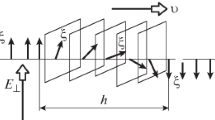Abstract
The motion of the type-II enzyme-DNA complex along the DNA chain is described in the framework of the model of chiral kink movement under the action of a transverse electric field of moderate strength and the model of proper kinetic equations. The basic enzyme characteristics are estimated. The energy released during catalytic reactions due to the participation of certain metal-ions is used to produce bending and twisting of the DNA, the angular motion, and the linear movement of the enzyme along the DNA chain. When water molecules and ions are expelled from the protein-DNA interface, a large longitudinal force appears in the motor, which strives to turn the deformed part of the DNA chain around the transverse axis, which can scissor the DNA chain in some “weak” place inside the enzyme groove.
Similar content being viewed by others
References
A. Yuan, Biochem. Rev. 50, 285 (1981).
A. Pingoud and A. Jeltsch, Eur. J. Biochem. 246, 1 (1997).
N. Y. Sidorova, Proc. Natl. Acad. Sci. USA 93, 12 272 (1996).
D. Kostrewa and F. K. Winkler, Biochemistry 34, 683 (1995).
M. Newman, T. Strzelecka, L. F. Dorner, et al., Science (Washington) 269, 656 (1995).
J. F. Thompson and A. Landy, Nucleic Acids Res. 16, 9687 (1988).
M. T. Record, C. F. Anderson, and T. M. Lohman, Q. Rev. Biophys. 11, 103 (1978).
A. Jeltsch, H. Wolfes, G. Maass, and A. Pingoud, Proc. Natl. Acad. Sci. USA 90, 8499 (1996).
S. Pikin and W. Haase, Zh. Éksp. Teor. Fiz. 119(1), 199 (2001) [JETP 92 (1), 174 (2001)].
S. A. Pikin, Structural Transformations in Liquid Crystals (Gordon and Breach, New York, 1991); V. L. Indenbom, S. A. Pikin, and E. B. Loginov, Kristallografiya 21 (6), 1093 (1976) [Sov. Phys. Crystallogr. 21 (6), 632 (1976)].
E. Demikhov, S. A. Pikin, and E. S. Pikina, Phys. Rev. E: Stat. Phys., Plasmas, Fluids, Relat. Interdiscip. Top. 52, 6250 (1995).
H.-J. Ehbrecht, A. Pingoud, C. Urbanke, et al., J. Biol. Chem. 260, 6160 (1985).
E. B. Loginov and S. A. Pikin, Kristallografiya 51(2), 335 (2006) [Crystallogr. Rep. 51 (2), 308 (2006)].
Author information
Authors and Affiliations
Corresponding author
Additional information
Published in Russian in Kristallografiya, 2007, Vol. 52, No. 6, pp. 1131–1136.
The text was submitted by the author in English.




